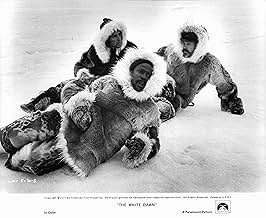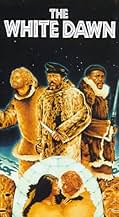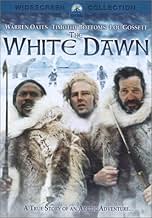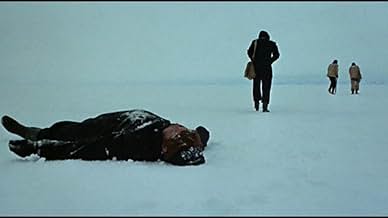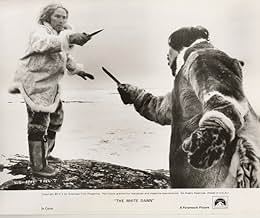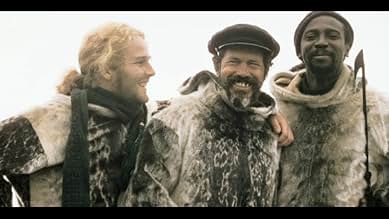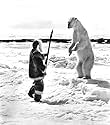In 1896, three survivors of a whaling ship-wreck in the Canadian Arctic are saved and adopted by an Eskimo tribe but frictions arise when the three start misbehaving.In 1896, three survivors of a whaling ship-wreck in the Canadian Arctic are saved and adopted by an Eskimo tribe but frictions arise when the three start misbehaving.In 1896, three survivors of a whaling ship-wreck in the Canadian Arctic are saved and adopted by an Eskimo tribe but frictions arise when the three start misbehaving.
Louis Gossett Jr.
- Portagee
- (as Lou Gossett)
Ann Meekitjuk Hanson
- Neevee
- (as Pilitak)
Featured reviews
Full disclosure I only watched this film because I admire Warren Oates and I had recently watched The Paper Chase and enjoyed Timothy Bottoms in that movie. I had only a vague notion of the theme of White Dawn and checked it out from my local library.
To begin I disapprove of seeing this film as good vs bad or savage vs civilized. I see far too many summaries of this film through that lens. The story, evidently, based on real events and was subject of a novel of the same name White Dawn, tells of four men who were part of an American whaling vessel in the Baffin Bay and while on a whale hunt are wrecked and stranded on the Baffin Island. The ship thinking those men dead turn about and sail home. One of the four stranded men died early on and we know nothing of him. The three remaining men struggle across the frozen barren until fortuitously they are discovered by some Inuits. The men are taken in and fed and provided shelter. Over time the men are initially given respect and are given wives, although Oates character is a devious man who wins his wives in a game. Naturally there are cultural misunderstandings and this eventually turns to friction. The Inuits are occasionally visited by a shaman who warns the tribe the newcomers are trouble. Somewhat a slow film but it builds to a tragic end.
The film is beautifully shot. We see a seal and walrus hunt and it appears to give an authentic look at Inuit life. I say appears because I am no authority on the Inuits, but the author of the novel, James Houston, on which the film was based lived with the Inuits to learn their ways, so I am trusting his observations. We see the Inuit life is hard and simple. It alludes the Inuits occasionally suffer from starvation. The film was shot on location where the events happened. You get a sense of the isolation of the place.
Overall I enjoyed the film, mainly because I was fascinated with a look at a people oftentimes forgotten and of the location which is isolated and formidable. Oates, Gossett and Bottoms deliver great performances.
To begin I disapprove of seeing this film as good vs bad or savage vs civilized. I see far too many summaries of this film through that lens. The story, evidently, based on real events and was subject of a novel of the same name White Dawn, tells of four men who were part of an American whaling vessel in the Baffin Bay and while on a whale hunt are wrecked and stranded on the Baffin Island. The ship thinking those men dead turn about and sail home. One of the four stranded men died early on and we know nothing of him. The three remaining men struggle across the frozen barren until fortuitously they are discovered by some Inuits. The men are taken in and fed and provided shelter. Over time the men are initially given respect and are given wives, although Oates character is a devious man who wins his wives in a game. Naturally there are cultural misunderstandings and this eventually turns to friction. The Inuits are occasionally visited by a shaman who warns the tribe the newcomers are trouble. Somewhat a slow film but it builds to a tragic end.
The film is beautifully shot. We see a seal and walrus hunt and it appears to give an authentic look at Inuit life. I say appears because I am no authority on the Inuits, but the author of the novel, James Houston, on which the film was based lived with the Inuits to learn their ways, so I am trusting his observations. We see the Inuit life is hard and simple. It alludes the Inuits occasionally suffer from starvation. The film was shot on location where the events happened. You get a sense of the isolation of the place.
Overall I enjoyed the film, mainly because I was fascinated with a look at a people oftentimes forgotten and of the location which is isolated and formidable. Oates, Gossett and Bottoms deliver great performances.
Truth told there's something about the movie that doesn't work, something that stops it just short of fulfilling the potential promised by the setting, story, and talent involved. The problem is not that there's little of plot to speak of because this is the kind of movie that actually benefits from thin plotting but still something seems to be missing.
It could be that the movie follows in episodic fashion the life and misadventures of three whalers stranded in Arctic Canada who are saved from certain death by a group of Eskimos but does so without urgency, capturing an evocative snapshot of Eskimo life, perhaps very faithfully, but still in a very Discovery Channel kind of way. Sure, bears and sea otters are slaughtered for food, but it's that, natives trying to survive in their natural habitat the only way they know, not castaways desperately trying to survive in a hostile world the only way they can. We don't see the three fishes out of water struggling to survive, most everything (food, shelter, even women) is provided for them by the friendly Eskimos.
It could be that the movie is designed, conceived, as a mood piece yet is shot in a very generic by-the-numbers way. If Philip Kaufman captures no small amount of awe-inspiring shots of the glacial Canadian landscape where the movie was shot, it's because he had little more to do than point the camera at any direction around him to get them. You can imagine how much more potential someone like Werner Herzog could have milked out of a setting like this. The individual shots are good but the way they're strung together is mundane and workmanlike.
It could be that for a grim and visceral 'man in the wilderness' adventure, WHITE DAWN is really not very grim or visceral. Kaufman doesn't allow a sense of urgency frostbitten danger or impending doom to seep in. When the three whalers make a run for freedom with a stolen Eskimo boat only to find themselves stranded in the ice again, an Eskimo conveniently shows up to lead them back to safety. Misguidedly the emphasis here is on picturesque rather than bleak. Compare how the three whalers are treated by the friendly wife-sharing Eskimos to the gruesome fate that is reserved in the hands of Algonquin Indians for the Catholic missionaries in Bruce Beresford's BLACK ROBE and the difference highlights a lot of what makes WHITE DAWN a mostly lighthearted affair.
Still, not unlike Nicholas Ray's THE SAVAGE INNOCENTS, a lot of the small vignettes that show the whalers cohabiting with the Eskimos are a lot of fun to watch. Chief among the one where Warren Oates cons a man out of his two daughters in a knife-throwing betting contest. But unlike Ray's movie, THE WHITE DAWN hovers plot less, suspended between beautiful scenery and Eskimo customs, for a little too long.
Perhaps it's the combination of all the above reasons that makes WHITE DAWN an interesting watchable movie, one closer to a hit than a miss. Warren Oates as the grizzly scruffy third mate is a pleasure to watch, this is the kind of character he could play with eyes closed and that's pretty much what he does. And then there's the ending, which I won't spoil, that couldn't have come from anywhere else than typically disillusioned 70's American cinema.
It could be that the movie follows in episodic fashion the life and misadventures of three whalers stranded in Arctic Canada who are saved from certain death by a group of Eskimos but does so without urgency, capturing an evocative snapshot of Eskimo life, perhaps very faithfully, but still in a very Discovery Channel kind of way. Sure, bears and sea otters are slaughtered for food, but it's that, natives trying to survive in their natural habitat the only way they know, not castaways desperately trying to survive in a hostile world the only way they can. We don't see the three fishes out of water struggling to survive, most everything (food, shelter, even women) is provided for them by the friendly Eskimos.
It could be that the movie is designed, conceived, as a mood piece yet is shot in a very generic by-the-numbers way. If Philip Kaufman captures no small amount of awe-inspiring shots of the glacial Canadian landscape where the movie was shot, it's because he had little more to do than point the camera at any direction around him to get them. You can imagine how much more potential someone like Werner Herzog could have milked out of a setting like this. The individual shots are good but the way they're strung together is mundane and workmanlike.
It could be that for a grim and visceral 'man in the wilderness' adventure, WHITE DAWN is really not very grim or visceral. Kaufman doesn't allow a sense of urgency frostbitten danger or impending doom to seep in. When the three whalers make a run for freedom with a stolen Eskimo boat only to find themselves stranded in the ice again, an Eskimo conveniently shows up to lead them back to safety. Misguidedly the emphasis here is on picturesque rather than bleak. Compare how the three whalers are treated by the friendly wife-sharing Eskimos to the gruesome fate that is reserved in the hands of Algonquin Indians for the Catholic missionaries in Bruce Beresford's BLACK ROBE and the difference highlights a lot of what makes WHITE DAWN a mostly lighthearted affair.
Still, not unlike Nicholas Ray's THE SAVAGE INNOCENTS, a lot of the small vignettes that show the whalers cohabiting with the Eskimos are a lot of fun to watch. Chief among the one where Warren Oates cons a man out of his two daughters in a knife-throwing betting contest. But unlike Ray's movie, THE WHITE DAWN hovers plot less, suspended between beautiful scenery and Eskimo customs, for a little too long.
Perhaps it's the combination of all the above reasons that makes WHITE DAWN an interesting watchable movie, one closer to a hit than a miss. Warren Oates as the grizzly scruffy third mate is a pleasure to watch, this is the kind of character he could play with eyes closed and that's pretty much what he does. And then there's the ending, which I won't spoil, that couldn't have come from anywhere else than typically disillusioned 70's American cinema.
This little-known film of Philip Kaufman's is a look at a culture not seen much in films, that of the Innuit, or Eskimo people of Arctic Canada. Three whalers (Warren Oates, Timothy Bottoms and Louis Gosset Jr.) are stranded among them after a shipwreck. The year is 1896 but it could just as well be 1996 or 1796 as far as we can tell in this simple world where survival against nature is always the biggest concern. Surprisingly to me, the culture clash does not seem to be that great through most of the movie, and when it comes, it does so rather quickly. I think this makes for a less strong film but it's still an interesting one that really fascinates at times.
Cinematographer Michael Chapman ('Raging Bull') provides some great shots of the Great White North and Henry Mancini's score is very nice also. Martin Ransohoff is usually known as a producer but co-wrote the script here with Thomas Rickman.
Cinematographer Michael Chapman ('Raging Bull') provides some great shots of the Great White North and Henry Mancini's score is very nice also. Martin Ransohoff is usually known as a producer but co-wrote the script here with Thomas Rickman.
I saw this film last year at the Chicago International Film Festival with Philip Kaufman and Prof. Annette Insdorf presenting and I was totally blown away. It is both a beautiful love story between a white man and an Inuit woman and a big, spectacular adventure film. There are some amazing scenes, one involving polar bear (this scene alone is amazing and worth seeing the film for) , seal hunting, walrus hunting, boating in the treacherous ice-floes, etc. The performances are excellent from Timothy Bottoms , Warren Oates, Louis Gosset, Jr. and the wonderful actors of the Inuit community. The film continually takes your breath away and has some of the most beautiful love scenes I've ever seen. It's apparently based on a true story of the first encounter of the Inuit with the Dog Children (us). The film has some heartbreaking scenes (which I won't discuss) and the acting by the untrained Inuit actors is truly spectacular. I can't recommend this film enough.
This movie contains what is surely one of the strangest, most unique, and most fascinating scenes in the history of cinematography.
The scene is of an Inuit (Eskimo) ritual. I believe it to be authentic. The screenwriter (who also wrote the original book) lived among and studied the Inuit people for decades and was probably one of the world's foremost (non-Inuit) experts on Inuit culture. Furthermore, the movie was filmed on location and using actual Inuit people as actors.
In the ritual, two girls sit cross-legged on the floor, facing each other. They seal their mouths together and take turns blowing air forcefully across the vocal cords of the other person. It creates one of the eeriest sounds I've ever heard. It's kind of a continuous huffing dronal chant, reminiscent of the background drone of bagpipes but without the shrillness. The strangest aspect of it is that there is an undertone of human voices in the sound. You get the feeling that if you listened hard enough, you could make out actual words. It is like no other sound you've ever heard - hair-raising. Who could have ever imagined that the human body could produce such a sound? Basically what they are doing is playing the other person's body like a musical instrument.
The girls continue doing this, apparently for hours, hardly stopping to take a breath. They've got to be hyperventilating, or experiencing a buildup of carbon dioxide in their lungs and blood, and it is incredible that they can go on and on like this without fainting. They must go into some kind of dizzy trance-like state.
I have never seen or heard of this ritual/technique anywhere but in this movie. I was in Alaska the summer of its Centennial year (1967) and was so fortunate to see a great many demonstrations of Inuit culture as part of the celebrations. But I didn't see anything like this, nor have I come across any description of it in my reading.
This movie would be worth seeing, preserving, and collecting on the basis of this one scene alone! (But actually the rest of it is also worth seeing.)
The scene is of an Inuit (Eskimo) ritual. I believe it to be authentic. The screenwriter (who also wrote the original book) lived among and studied the Inuit people for decades and was probably one of the world's foremost (non-Inuit) experts on Inuit culture. Furthermore, the movie was filmed on location and using actual Inuit people as actors.
In the ritual, two girls sit cross-legged on the floor, facing each other. They seal their mouths together and take turns blowing air forcefully across the vocal cords of the other person. It creates one of the eeriest sounds I've ever heard. It's kind of a continuous huffing dronal chant, reminiscent of the background drone of bagpipes but without the shrillness. The strangest aspect of it is that there is an undertone of human voices in the sound. You get the feeling that if you listened hard enough, you could make out actual words. It is like no other sound you've ever heard - hair-raising. Who could have ever imagined that the human body could produce such a sound? Basically what they are doing is playing the other person's body like a musical instrument.
The girls continue doing this, apparently for hours, hardly stopping to take a breath. They've got to be hyperventilating, or experiencing a buildup of carbon dioxide in their lungs and blood, and it is incredible that they can go on and on like this without fainting. They must go into some kind of dizzy trance-like state.
I have never seen or heard of this ritual/technique anywhere but in this movie. I was in Alaska the summer of its Centennial year (1967) and was so fortunate to see a great many demonstrations of Inuit culture as part of the celebrations. But I didn't see anything like this, nor have I come across any description of it in my reading.
This movie would be worth seeing, preserving, and collecting on the basis of this one scene alone! (But actually the rest of it is also worth seeing.)
Did you know
- TriviaAccording to producer Irwin Winkler, this movie was the main factor in his decision to invite director Philip Kaufman to direct L'étoffe des héros (1983). Portions of Henry Mancini's score for this film can be heard in the later film.
- Alternate versionsThe film was originally given an "R" rating from the MPAA due to the nudity which was then edited for the film to receive a "PG" rating.
- ConnectionsReferenced in Realizing 'The Right Stuff' (2003)
- How long is The White Dawn?Powered by Alexa
Details
Box office
- Budget
- $1,700,000 (estimated)
Contribute to this page
Suggest an edit or add missing content


